Population, population movements in Hungary, 2014.
| Major population data at the beginning of the year | |||||
| name | 2001 | 2012 | 2013 | 2014 | 2015 |
| Population | |||||
| Male, thousand | 4.851 | 4.725 | 4.716 | 4.703 | 4.696 |
| Female, thousand | 5.349 | 5.207 | 5.193 | 5.174 | 5.160 |
| Summary, thousand | 10.200 | 9.932 | 9.909 | 9.877 | 9.856 |
| Female/ thousand male | 1.103 | 1.102 | 1.101 | 1.100 | 1.099 |
| Population distributed in city types, % | |||||
| Budapest | 17,2 | 17,4 | 17,5 | 17,7 | 17,8 |
| Other cities | 52,8 | 52,9 | 52.8 | 52,7 | 52,7 |
| Villages | 29,9 | 29,7 | 29,7 | 29,6 | 29,5 |
Source: KSH Hungary No. 2014. [1]
The population of Hungary shows reduction. This is caused by the low number of child births.
The majority of the population lives in the capital and other major cities. The population of lesser cities and villages slowly decreases.
| Major population movement data, 2014. | |||||
| Name | 2001 | 2011 | 2012 | 2013 | 2014 |
| /thousand residents | |||||
| Live-birth | 9,5 | 8,8 | 9,1 | 9,0 | 9,3 |
| deaths | 13,0 | 12,9 | 13,0 | 12,8 | 12,8 |
| marriages | 4,3 | 3,6 | 3,6 | 3,7 | 3,9 |
| divorces | 2,4 | 2,3 | 2,2 | 2,0 | 2,0 |
| Infant mortality /1000 | 8,1 | 4,9 | 4,9 | 5,1 | 4,6 |
| Children born outside of marriages, % | 30,3 | 42,3 | 44,5 | 46,2 | 47,6 |
| Complete fertility rate | 1,31 | 1,24 | 1,34 | 1,34 | 1,41 |
| Expected lifetime, year | 72,3 | 74,7 | 75,0 | 75,5 | 75,6 |
| Male | 68,2 | 70,9 | 71,5 | 72,0 | 72,1 |
| Female | 76,5 | 78,2 | 78,4 | 78,7 | 78,9 |
Source: Central Office of Statistics, 2015. Hungary [2]
According to the past one or two year the number of live-births is stagnant, with minimal growth. The relatively high number of children born outside of marriages projects the need of employment inside families regarding elders. The rising number of expected lifetime at the time of birth gives more opportunities for the employment of elders.
| Population’s age distribution, ratio of dependents 2014. | |||||
| % | |||||
| Name | 2001 | 2012 | 2013 | 2014 | 2015 |
| Elders in regard of children | 91,2 | 116,4 | 118,9 | 121,5 | 123,6 |
| Age constitution | |||||
| 14 and younger | 16,6 | 14,5 | 14,4 | 14,4 | 14,5 |
| 15-64 years’ old | 68,3 | 68,6 | 68,4 | 68,0 | 67,6 |
| 65 or older | 15,1 | 16,9 | 17,2 | 17,5 | 17,9 |
| Related to 15-64 years olds | |||||
| Child population | 24,3 | 21,1 | 21,1 | 21,2 | 21,4 |
| Elder population | 22,2 | 24,6 | 25,1 | 25,8 | 26,5 |
Source: KSH Hungary No. 2014.
The aging population – and the old Europe attribute– is best described by the constant increase of the elders and the number of children in the population.
The decrease of the 14 or younger shows that the populational „reinforcement” is lacking.
The number of live-births, the lengthened life of elders affects the shape and indicators of the demographic tree and will continue to do so in the coming decades.
The high number of 40 and 60 years old is representative of Hungary, who are the generations of the Ratkó era (1950s’ Hungary), when abortions were banned by law.
The increase in lifetime is a social and economic challenge which can be answered by a meaningful and productive old age, by creating opportunities to make the knowledge transfer between generations happen.
Employment, unemployment in Hungary, 2014.
| Employment, unemployment (between the ages of 15-64) | |||
| Name | 2012 | 2013 | 2014 |
| Employment | |||
| Number of employed, thousand | 3.792,8 | 3.860 | 4.069,9 |
| Employment rate, % | 56,7 | 58,1 | 61,8 |
| Male | 61,6 | 63,7 | 67,8 |
| Female | 51,9 | 52,61 | 55,9 |
| Part-time employment, % | 6,7 | 6,4 | 6,0 |
| Number of employees with defined labour- contracts | 9,5 | 10,9 | 10,8 |
| Unemployment | |||
| Unemployed, thousand | 472,2 | 440,2 | 342,7 |
| Unemployed rate, % | 11,1 | 10,2 | 7,8 |
| Male | 11,4 | 10,3 | 7,6 |
| Female | 10,7 | 10,2 | 8,0 |
Source: KSH Hungary No. 2014.
According to KSH’s data, the number of employments is increasing while the unemployment rate is decreasing.
Note that the numbers contain the communal workers and the Hungarians working in other European countries.
Part-time employees are reducing. This field would be ideal potential to active pensioners – an opportunity to stay in or to re-enter the working force”.
IN Hungary the job opportunities decrease from west to east. Counties with especially bad positions are Borsod-Abaúj-Zemplén, Szabolcs-Szatmár-Bereg. In these counties the employment of active pensioners is increasingly hard.
Rate of employment and unemployment in regard to the highest education level, Hungary 2014. (between the ages of 15-64)
The level of education and the employment rate/unemployment rate shows clearly that higher education has a positive effect on the labour-market in Hungary.
The increasing number of higher education can be observed in growing the elder population. An educated, active pensioner layer will be strongly present in the coming decade of the XXI. Century which necessitates new services and employment opportunities regarding elders and age management.
Statistical data of employment and elders, pensioner policy
The European Commission made an announcement to the European Parliament and Council, called „Europe’s answer to the aging world – promoting social and economic advance in an aging world – in march. 2002. This document was the European Commission’s participation in the second world conference about aging. According to the communique the first thing to address in Europe is aging. While the number of elders in the world is around 10%, in the members of EU-15 this number is more than 20%. Population predictions expect that in 2050, people of 60 and older will construct 30-40%!
The rate of elders to youngsters is an important indication of aging factors. The number of people older than 60 were higher than the population of 0-14 in 1990. Presently the population of 65 and older outnumbers 0-14 years olds, and this tendency increases very quickly, it is predicted to be bigger than the ’19 and younger’ by 2020.
Ratio of elders and juniors
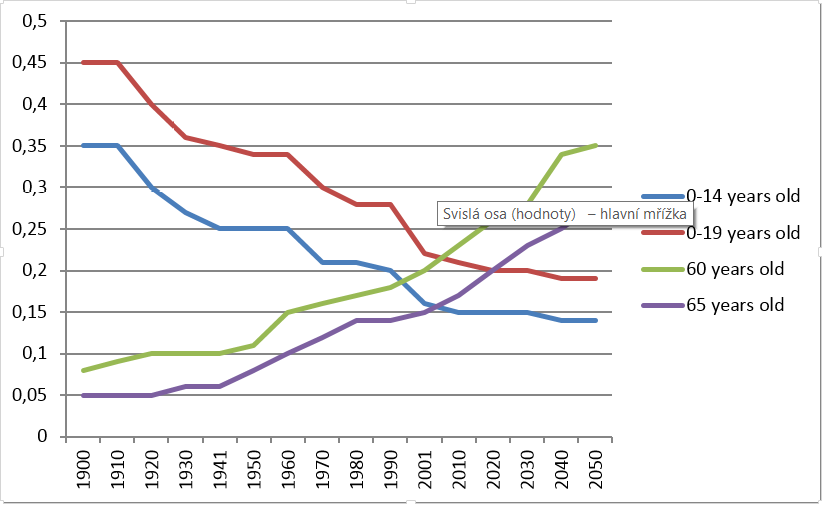
The aging of population is a basic demographic process. The labour-market is approaching important chances parallel with the demographic ones, since the aging population forces the structures of economy and market to adapt to the decreasing number of workforce. This process is ever more present in Hungary.
Aging and labour-participation
The employment rate of elders in Hungary is significantly lower than in other European countries. According to a labour-force survey, 60% of the 55-64 years old males were employed in the EU, this number is half in Hungary. The number of employed 55-64 years old females are 10% behind the union’s 45%.
Employment rates in the EU and in Hungary, representing gender and age groups, 2014.
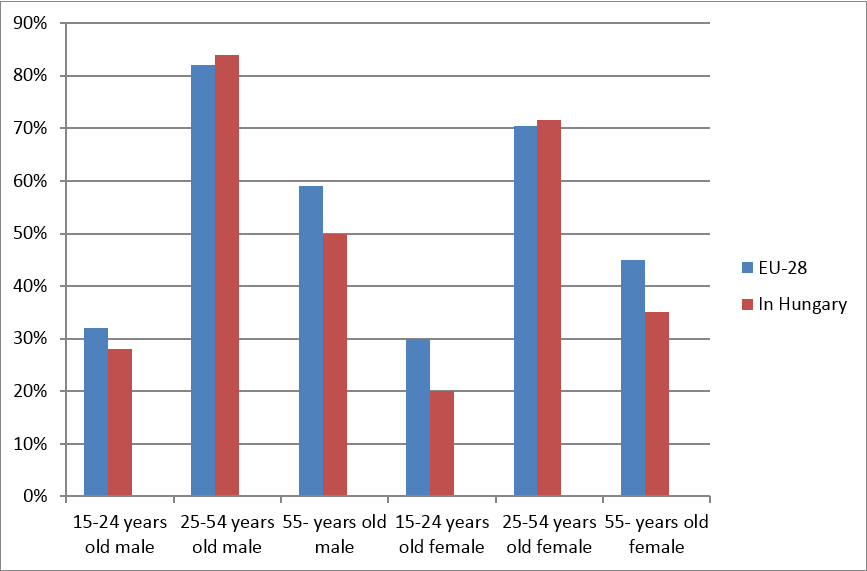
Source: KSH workforce-survey and supplementary data (Hungary, 2014.) [3]
The workforce contingent leaving due to pensionage is not fully separated from the productive work. Although one of the major plans for old age is taking care of the younger generation, the number of elders who want to do some kind of job is significant. Half of the surveyed stated that they would like to have some work next to their other plans. Two-third of the above usually managed to accomplish this. 40% of males and 36% of females successfully rejoin the workforce with flexible working hours. The fields are ordinarily civil, church or private spheres with work hours ranging from 4-6 or occasional jobs.
Working beside pension, plans and reality, 2013.
| Name | Planned | Managed to |
| Male | ||
| Flexible work hours | 54,4 | 22,9 |
| Starts an enterprise | 18,2 | 10,3 |
| Have a job, part of full-time | 38,6 | 26,4 |
| Does an agricultural, productive work | 25,5 | 15,6 |
| Takes a significant role in raising children, grandchildren | 86,6 | 40,6 |
| Female | ||
| Flexible work hours | 51,9 | 18,9 |
| Starts an enterprise | 11,8 | 4,5 |
| Have a job, part of full-time | 39,3 | 24,7 |
| Does an agricultural, productive work | 16,2 | 7,7 |
| Takes a significant role in raising children, grandchildren | 86,8 | 55,3 |
Source: KSH Turning points of our lives Records (Hungary, 2013.)
Pension and income situation
According to household statistics the financial situation of elders is preferable to young adults, especially to those who have children. Pensioner state does not mean financial insecurity as pension is a dependable, constant source of income. In addition, it is also important to keep in mind, that the riches collected until pensionage also play an important role in determining the quality of this lifetime.
Besides financial transfers supporting their adult children with their time, work and reorganized lives are very important to the presently aging generation. In Hungary this work is called ’household-childcare’ work – without compensations.
Duties of adult children according to their parents by age groups, 2013
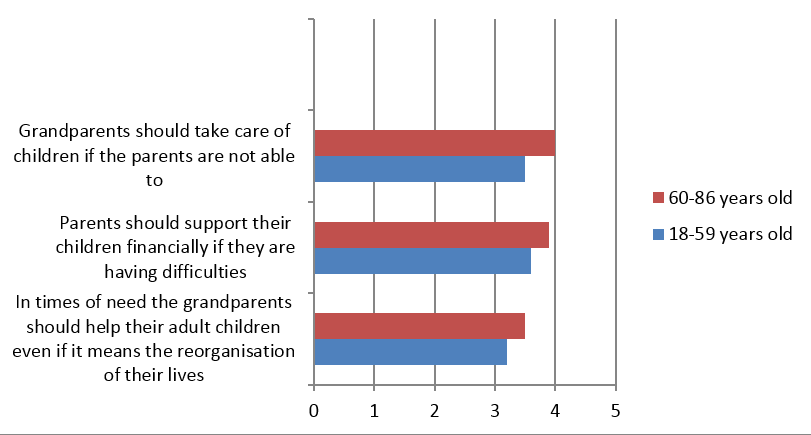
Source: KSH Turning points of our lives Records (Hungary, 2013.)
Voluntary work after pension
The issue of aging is naturally not as narrow as finances, consistent and adaptive pension policies and high-end healthcare. It is necessary to take into account the activities after pensionage or healthcare programs in order to achieve a harmonic existence between generations. Programs of the University of Third Age Miskolc (for example: „Lets go together Granny – Lets play together, Grandma” or the [4] courses (my grandfather and me). The most important indicator of generational solidity is voluntary work. More than third of the 60 years old and above do voluntary work, most of them help out in the family, but friends and acquaintances also receive help (20–20%).
Voluntary work of 55-74, and those for whom it was done, 2014
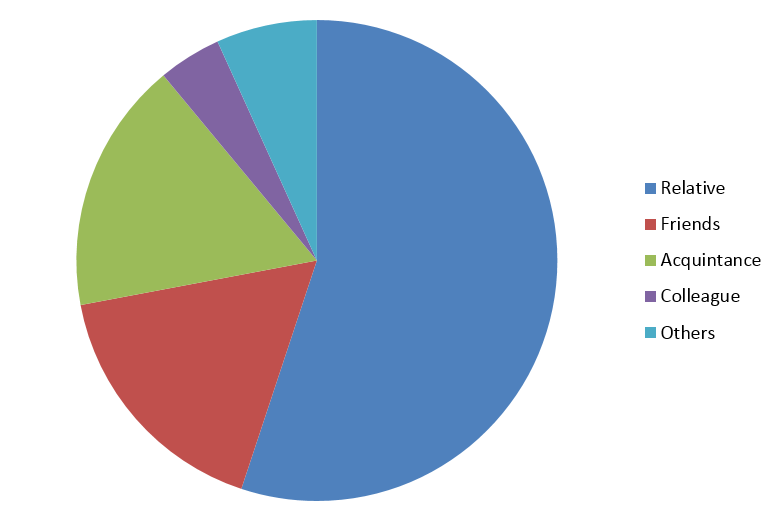
Source: KSH Hungary No. 2014. 5]
Besides the health preservation programs travelling helps to keep the mind occupied and the body active. 35% of elders above 65 can afford to travel abroad once a year. 10% solely travel for the purpose of health preservation. University of Third Age Miskolc’s target groups cooperate with the Health-Improvement Office (EFI) Miskolc to create health preservation programs.
Opinions about life – according to 60-84 years old, 2013.
| Name | False | Slightly false | Slightly true | True |
| Trust in the future | 11 | 24 | 40 | 25 |
| Cannot control everyday life | 34 | 34 | 24 | 8 |
| Life is so complicated nowadays, I do not know what to do |
35 | 30 | 25 | 10 |
| Those who want a lot of things in life sometimes need to break the rules | 26 | 23 | 33 | 17 |
| Cannot find happiness in work | 66 | 22 | 8 | 4 |
| Nobody cares about others | 24 | 27 | 32 | 17 |
Source: KSH Turning points of our lives Records (Hungary, 2013.)
Goals of national travels, 2014.
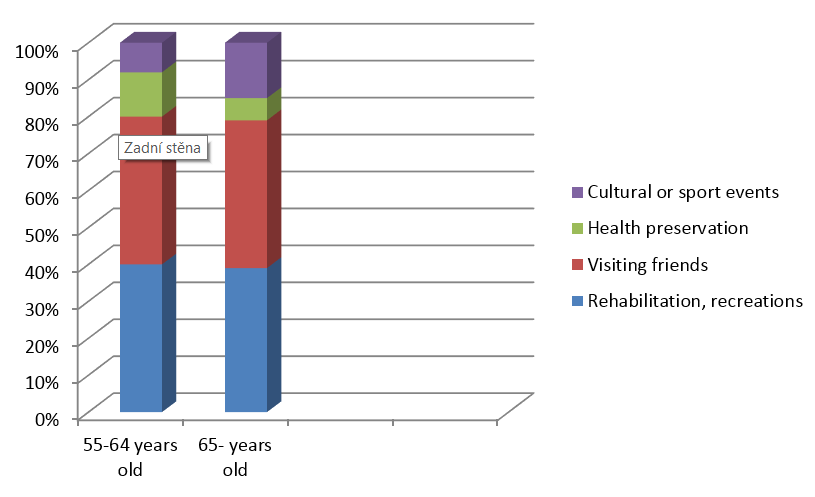
It is an important goal to make the elders feel as a productive member of a society so that they do not lose their independency and do not become isolated. Subjective pointers about social interdependency between generations are the feeling of inadequacy, the appreciation of the elders’ work and the trust in the future. According to researches, near half of the people above 60 think that other people care about each other, and two-third of them trust in the future. The University of Third Age Miskolc Foundation – regionally, in the county– provides travel and touristic opportunities to elders through the Elders Touristic Centre. The creation of „TOURageing Miskolc Cluster” will help to achieve national and international levels of expansion in 2017. Besides travelling activities, the employment and voluntary work of elders will be primary goals.
The challenge of the changing demographic situations, prognosis about the expected advances in the world – Europe and Hungary – until 2050
[6]According to UN predictions the population will be over 9,7 billion by 2050, and in 2100 it will be 11,2 billion – instead of the slowing tendencies in the second half of the century. (UN demographic changes, 2013)
Population of the world by continents, 1950-2100
In the XX century – in the whole world – expected lifetimes rose in unimaginable quantities: between 1950-1955 it was 47, now between 2010-2015 it increased by 24 years. The quality of life will be better in the following decades: global data predicts 77 years between 2045-2050, and in 2095-2100 it can be as high as 83 years. In developed countries life will last about 89 years, in developing countries lifespan will be 82 years.
Lifespan at time of birth, 1950-2100
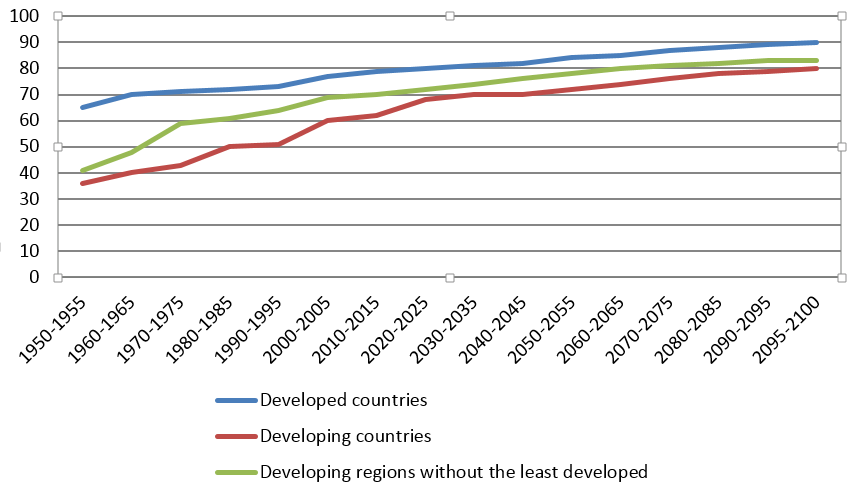
The expected decrease in childbirths resulting in death contributed to the lifespan increase. The death ratio of 5 years old and younger decreased dramatically: according to calculations, between 1950-1955 215 children died out of a thousand before living 5 years, between 2010-2015 only 50. 6,6 million children died in 2012 worldwide.
Low fertility paired with better life quality results in an aging population. This process is already under way in developed countries, in these places the number of elders (60 years and above – 24 %) outscores the young ones (15 and younger – 16 %) and by 2050 the number of elders is expected to be the double of the young (33 % and 16 % respectively).
(Source: KSH Hungary, 2014.)
[1] www.ksh.hu/docs/hun/xftp/idoszaki/mosz/mosz14.pdf
[2] www.ksh.hu/docs/hun/xftp/idoszaki/mosz/mosz14.pdf
[3] http://www.ksh.hu/docs/hun/xftp/stattukor/veneuropa.pdf
https://www.ksh.hu/docs/hun/modsz/modsz21.html
[4] The name of the training program:” Nagyapámésén@eu.infomatika”, Programacredited course in adult education 2004. University of Miskolc, program executive: Dr. Dobos László
[5] http://www.ksh.hu/docs/hun/xftp/stattukor/veneuropa.pdf
[6] www.ksh.hu/docs/hun/xftp/idoszaki/mosz/mosz14.pdf
https://www.ksh.hu/docs/hun/xftp/stattukor/nepesedesi15.pdf

